| Inside This Edition All About HIP: - Help HIP!
- Events
- Invasive Species Awareness Week
- Library Workshop
- Bucket Pickup
- Trade In Program
- New Boot Brush Stations
Programs and Services: - Native Plant Kit Sale
- New Items - Tool Loan Program
- Pre - Order Rain Barrels & Accessories
- Soil Testing Preparation
District News: - Outreach Updates
- Rain Garden Booklet
- Departure of Taylor
- Become an Affiliate Member this Year!
- Annual Meeting Recap
Conservation Corner: - Quick Sustainable Spring Cleaning Tips
- How to Properly Mulch Your Tree Article
Extras: - Master Gardener Program
- Herb Society's Spring Symposium
- USDA Announcement
- ICAN Early Childhood Tour
|
|
|
| | | | | Help Hamilton County Invasives Partnership (HIP) HIP is looking for volunteers! |
| HIP is made up of concerned citizens, property owners and managers and representatives from groups such as: municipalities, parks and recreation departments, environmental organizations, community groups, non-profits, businesses, and more.
While there are subject matter experts part of the HIP team, you certainly do not have be an expert to join. HIP is a great place to apply your knowledge and skills or learn. Programs: - Educational Events
- Boot Brush Stations
- GIS Invasive Species Monitoring
- Weed Wrangle Volunteer Workdays
- Strike Team Workdays
- Native for Invasive Trade In
- Workshops & Training
- Invasive Species Property Surveys
- and more!
|
| 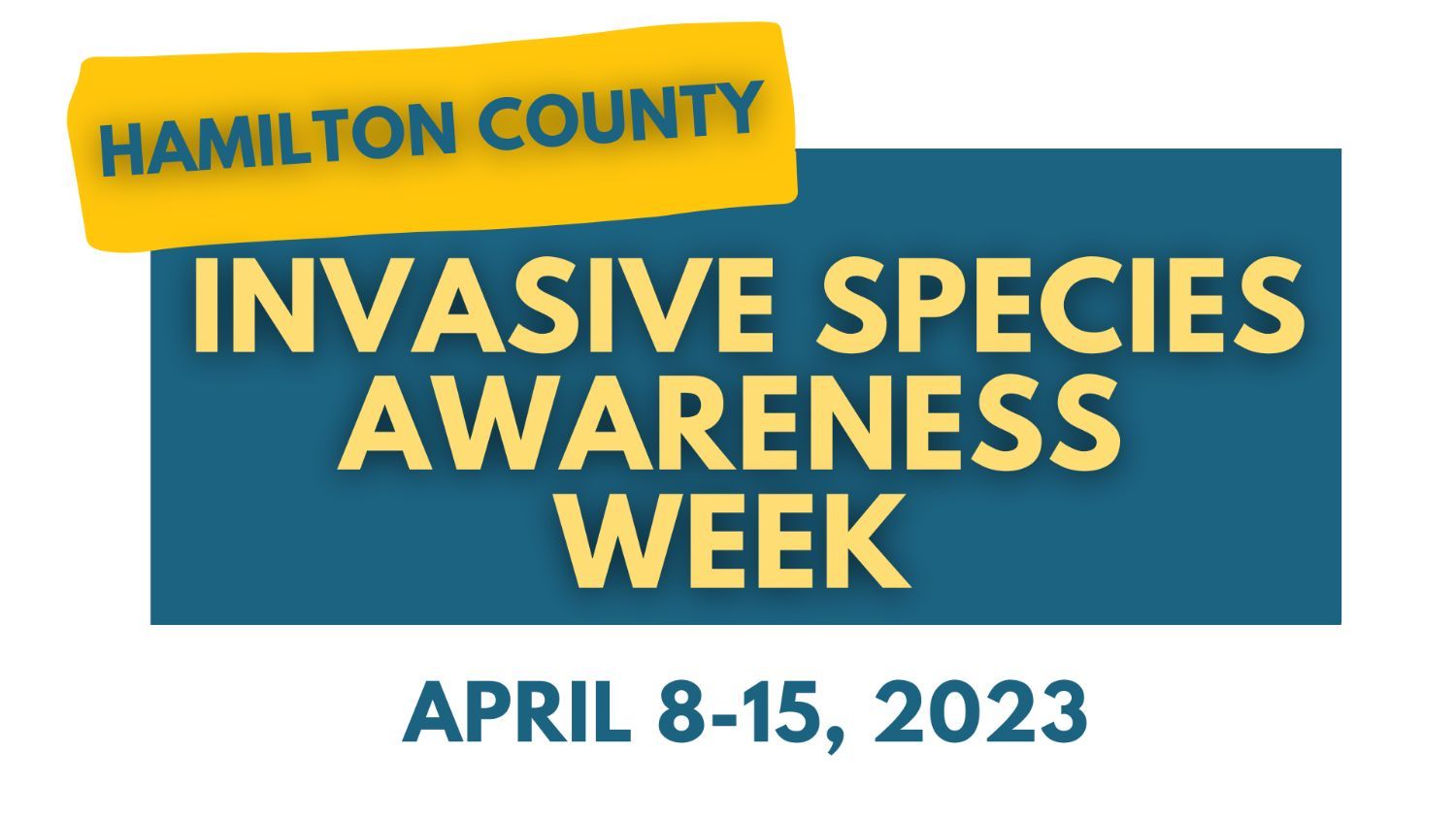 |
|
| The Hamilton County Invasives Partnership (HIP) was established in 2019 as the county's Cooperative Invasive Species Management Area (CISMA). The Partnership serves to unite land owners and managers, organizations, and citizens in the battle against invasive species and the destruction they cause across the county.
Vision: That Hamilton County's ecology, economy, and public health will be unobstructed by invasive species. |
| 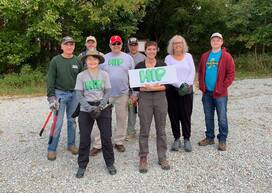 | | | |
|
| | |  | This spring, the Hamilton County Invasives Partnership is working with local partners to encourage citizens to “fill up to fight invasives” by providing a 5 gallon bucket to use in invasive species management.
Special HIP buckets with invasive garlic mustard information are available for free from the Hamilton County Soil and Water Conservation District in Noblesville and other participating partners while supplies last.
Volunteer opportunities to take part in invasive species workday Weed Wrangles on public property can be found on the HIP events page.
We encourage you to post a photo of your full bucket on your social media or neighborhood community pages to show your friends and neighbors that you are removing invasive species! Studies show that seeing a neighbor, friend, or acquaintance removing invasives can serve as the perfect inspiration for other people to get started! Tag @hcinvasives so we can share your photo as well.
Remember-- after removing invasives, you qualify to apply for free natives trees or shrubs via our trade in program! |
|
|
| |  | Program Guidelines:
Invasive species must be properly identified, removed, and properly disposed of by the homeowner. Landscape plantings of callery pear species (bradford, Cleveland, etc.), burning bush, Japanese barberry, and Norway Maple are the preferred species for removal but you can apply when removing other invasive species listed on the Official Indiana Invasive Species Council Invasive Plant List (found here).
HIP and the SWCD reserve the right to change the program guidelines and requirements. |
| |
|
| | | |
|
| | |  | | Native Indiana plant kits take the guess work out of creating your native plant garden. Get a selection of tried and true native plants to create your own pollinator garden, shade garden, or rain garden. Kit info:
50 plant plugs per kit - (approximately 5 plugs of each species)
$135.00 per kit + tax
Orders and payment are due by March 30th but kits could sell out. Order early!
Pick up: Pre-ordered plant kits will be available for pick up the week of June 5th in Noblesville. More information will be emailed to customers as pick up approaches.
How many plants do I need?
Plugs should be planted at least 1 foot apart (1 kit =50 sq. ft. garden). You can plant your plugs 16 -18 inches apart to cover a larger area (100-120 sq. ft. garden) and allow them plenty of room as they mature. See example planting plans below. |
| |
|
| |
|
| 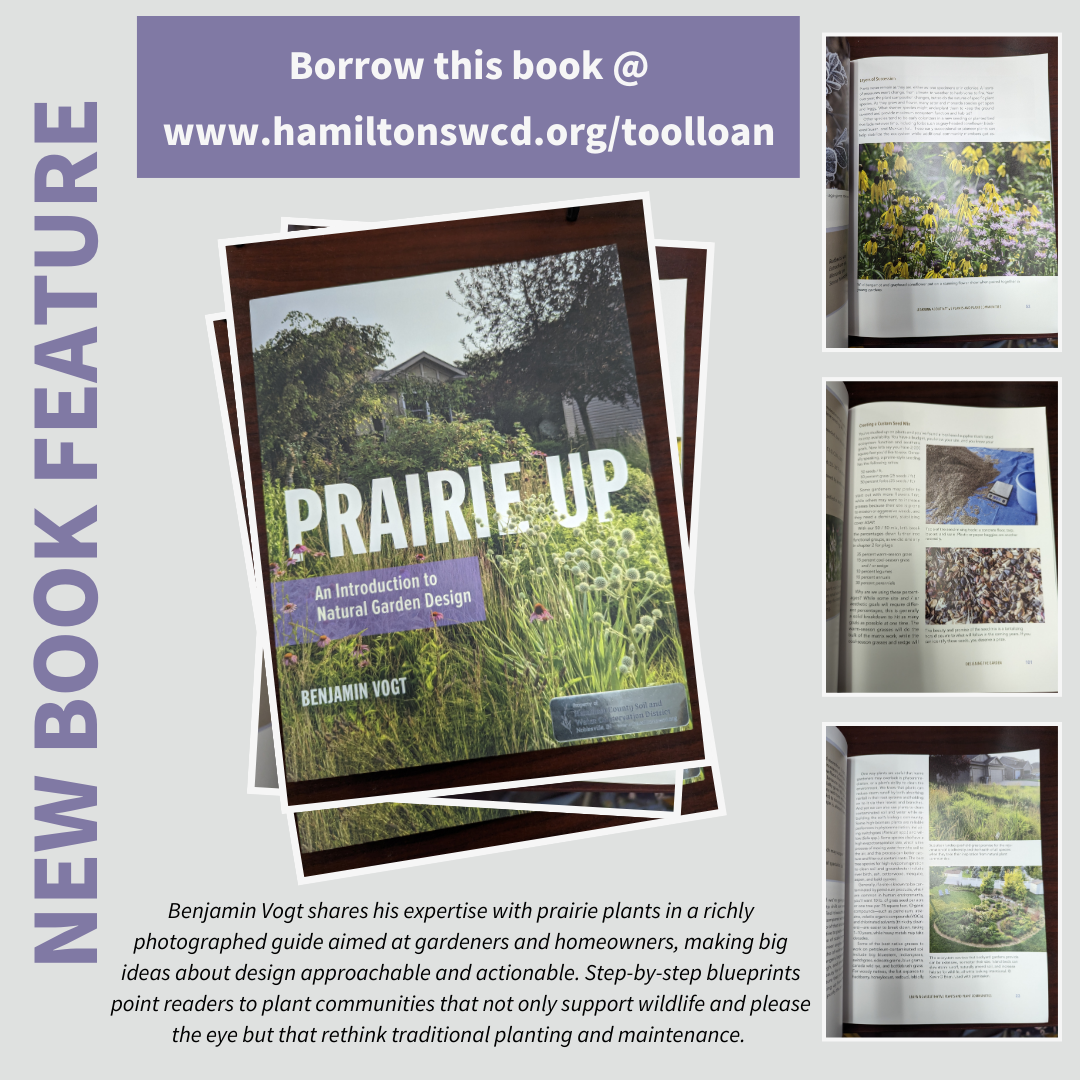 | The purpose of the tool loan program is to make tools and resources available to help Hamilton County residents achieve their conservation goals. The tools are able to be loaned out to Hamilton County residents for individual or group workdays on public or private lands in Hamilton County. When you're ready to place a reservation, create an account and add the item(s) to your cart. |
| |
|
| Rain Barrel Information and Sales Rain barrels & accessories are
currently pre-order only.
Pre-orders will close on April 27th and order pick up will be on Tuesday May 9th (3pm-6pm) and Wednesday May 10th (9am-1pm) in Noblesville (details will be emailed to customers as pick up approaches).
Additional barrels will be available for online order and office pick up starting May 11th. You do not need to be a Hamilton County, Indiana resident to place an order in any of the SWCD sales but you do need to pick up in Noblesville, Indiana. |
|
|
| Soil Testing in Preparation for your Spring Planting It may not quite seem like it, but Spring is not far away. Before you know it, things will be taking on a tinge of green, and in fact, flower bulbs like daffodils have already pushed through the soil and are beginning to swell at the tips, indicating a soon to be flower! For gardeners everywhere, we are beginning to think about what we may want to plant where, and what preparations may be needed for that. One good idea might be to have your soil tested, especially if you have never done that, or it has been a few years since the last one. Depending on the “crop” you intend to grow (i.e. vegetables, flowers, trees, lawn), you may need to apply certain amendments to create the ideal growing conditions. A healthy plant is more productive and resilient to adverse conditions (i.e. weather, disease, harmful insects, competition from weeds). Taking a soil sample to have it tested is really pretty simple. We have all the instructions on our web site https://www.hamiltonswcd.org/soil-testing.html. Basically, you will want to obtain a representative sample for the specific area you want to treat, whether that be a vegetable garden, a lawn, a shrub bed, etc. Once a soil sample is obtained, it should be mixed, and 2 cups will be taken from that to send into the lab (which we can do that). Most customers take the samples themselves and bring them to our office, where we will mix and take out a 2-cup portion. Results are usually available within about 7-10 days, and those can be emailed directly to you. What you will receive is a list of the current nutrient levels, the pH (how acidic or alkaline your soil is), organic matter content, and a few other things (which an explanation sheet will be provided for). You will also receive recommendations on what nutrient levels to apply (dependent on your intended “crop”), how much of each nutrient, how to adjust the pH if needed, and when to do all of this. Our Basic Test - $35 includes organic matter, phosphorus, potassium, calcium, magnesium, CEC, pH, and buffer pH. Our Complete Test- $45 includes the Basic Test plus conductivity, boron, copper, iron, manganese, sulfur and zinc. If you are interested in completing a test this spring, or any other time of the year, just follow the directions on our web site and submit a sample to our office. We will be happy to help. ~ Mark McCauley, Resource Conservationist |
|
|
| |
|
| | Rain gardens can help you manage rain on your property and clean water of contaminants! We have a FREE resource available for you! This booklet is available at our office Monday through Friday 8am to 4:30pm or by downloading a digital copy from our website. BUT that's not all.... You can also attend a program hosted by the Hamilton County Master Gardeners Association on April 1st. Claire Lane, Urban Conservationist, will be speaking on Rain Gardens. For more information, scroll down to the "Extras" section or click "Register Now" to the right. |
|
|
| | Become an Affiliate Member this Year! | Who are SWCD Affiliate Members?
Affiliate members are concerned about the conservation and proper use and care of our natural resources. Affiliate members are businesses who want to support district efforts and connect with landowners. Affiliate members are event attendees and program participants who were happy with the support they were provided and want to give back to the District.
Members include: - Farmers
- Homeowners
- Landowners
- Businesses and partner organizations
- Teachers & schools
- Community leaders
- Those who care about our environment.
| |
| |
|
Why is your membership important? By becoming an Affiliate Member of Hamilton County Soil & Water Conservation District, you are helping our organization provide services and educational programs which protect and enhance the natural resources of Hamilton County. Donations, whether volunteer hours or a financial contribution, are a valuable asset. Our supporters ensure we can hold workshops and programs for all ages, produce educational publications, establish demonstration sites, and support the many services offered by the SWCD. All levels receive a Friend of Conservation t-shirt and will be recognized at the Annual Meeting, on our brochure, and on our website. Partner and Champion of Conservation levels will receive ad space in all Town and County Newsletter, a link from our webpage and a social media post sharing your information and website. |
| Affiliate Membership Levels
$25+ Friend of Conservation
$50+ Compassionate Conservationist
$100+ Conservation Hero
$300+ Partner in Conservation (Advertisement offered)
$500+ Champion of Conservation (Advertisement offered)
Your donation is tax-deductible to the fullest extent of the law. |
|
|
| | | | | | | Mulch Your Trees The Right Way "Proper mulching of your trees is an important part of maintaining a healthy landscape. In this infographic you will learn all about proper mulching and how to mulch the right way. Most importantly you will avoid damaging your trees with improper mulching practices. In this infographic guide to mulching trees and shrubs you will also learn why mulching is so important!" You can read the full article here. |
| 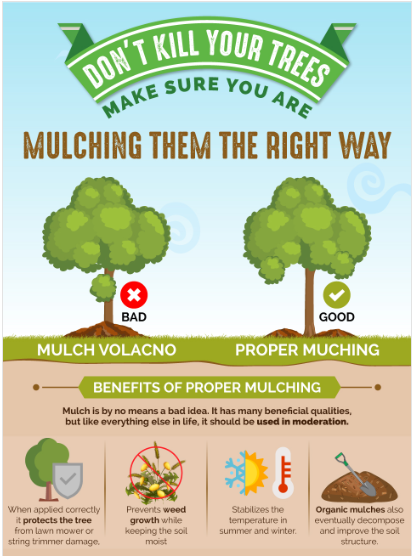 |
|
|
|
| | | 2023 Spring Symposium “Spice It Up With Ginger” Herb Society of Central Indiana April 29th, 2023 Hamilton County Fairgrounds We will celebrate 5,000 Years of the medicinal, spiritual, and culinary uses of amazingly versatile ginger. Speakers will include: |
|
|
| 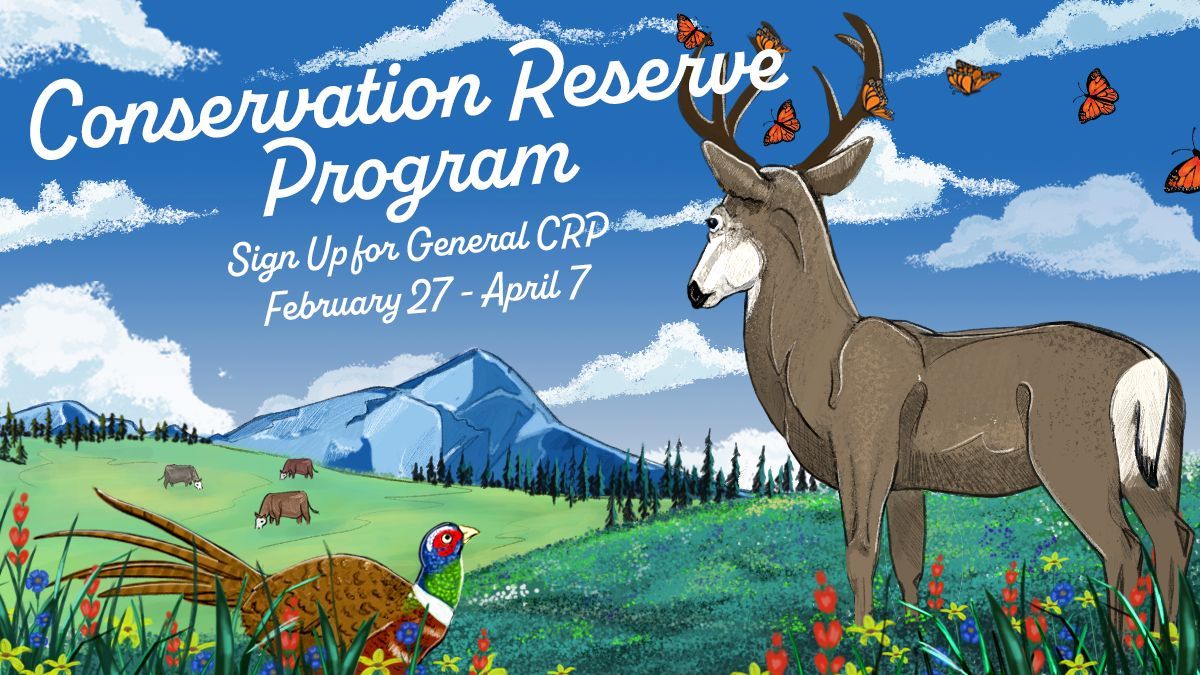 USDA Announces Conservation Reserve Program Signup for 2023 USDA Announces Conservation Reserve Program Signup for 2023 WASHINGTON, Feb. 16, 2023 – Agriculture Secretary Tom Vilsack announced that agricultural producers and private landowners can begin applying for the Conservation Reserve Program (CRP) General signup starting February 27 through April 7, 2023. CRP is a cornerstone voluntary conservation program offered by the U.S. Department of Agriculture (USDA) and a key tool in the Biden-Harris administration’s effort to address climate change and help agricultural communities invest in the long-term well-being of their land and natural resources. “The Conservation Reserve Program is one of the largest private lands conservation programs in the United States, offering a range of conservation options to farmers, ranchers and landowners,” Vilsack said. “CRP has and continues to be a great fit for farmers with less productive or marginal cropland, helping them re-establish valuable land cover to help improve water quality, prevent soil erosion, and support wildlife habitat. Under this administration, we have made several updates to the program to increase producer interest and enrollment, strengthen the climate benefits of the program and help ensure underserved producers can find a pathway to entry into CRP.” Producers and landowners enrolled more than 5 million acres into CRP through signups in 2022, building on the acceptance of more than 3.1 million acres in the largest Grassland CRP signup in history. There are currently 23 million acres enrolled in CRP, with 1.9 million set to expire this year. USDA’s Farm Service Agency (FSA) is aiming to reach the 27-million-acre cap statutorily set for fiscal year 2023. General CRP General CRP helps producers and landowners establish long-term, resource-conserving plant species, such as approved grasses or trees, to control soil erosion, improve water quality and enhance wildlife habitat on cropland. Additionally, General CRP includes a Climate-Smart Practice Incentive to help increase carbon sequestration and reduce greenhouse gas emissions by helping producers and landowners establish trees and permanent grasses, enhance wildlife habitat, and restore wetlands. Continuous CRP Under Continuous CRP, producers and landowners can enroll in CRP throughout the year. Offers are automatically accepted provided the producer and land meet the eligibility requirements and the enrollment levels do not exceed the statutory cap. The Climate-Smart Practice Incentive is also available in the Continuous signup. FSA offers several additional enrollment opportunities within Continuous CRP, including the Clean Lakes Estuaries and Rivers Initiative (CLEAR30), the State Acres for Wildlife Enhancement (SAFE) Initiative, the Farmable Wetlands Program (FWP), and the Conservation Reserve Enhancement Program (CREP). The CLEAR30 Initiative, which was originally piloted in twelve states in the Great Lakes and Chesapeake Bay watershed, has been expanded nationwide, allowing producers and landowners to enroll in 30-year CRP contracts for water quality practices. Under this administration, FSA also moved SAFE practices back to the Continuous CRP signup, giving producers and landowners more opportunities to participate in the initiative. Through the FWP, producers and landowners can enroll land in CRP as part of their efforts to restore previously farmed wetlands and wetland buffers, to improve both vegetation and water flow. This administration has also made significant improvements to CREP, which leverages federal and non-federal funds to target specific State, regional or nationally significant conservation concerns. Specifically, USDA made significant improvements to CREP to reduce barriers and make the program more accessible to a broad range of producers and new types of partners. These updates included flexibility for partners to provide matching funds in the form of cash, in-kind contributions, or technical assistance, along with an investment in additional staff to work directly with partners. Through CREP, for the first time ever, three Tribal Nations are now partnering with USDA to help conserve, maintain, and improve grassland productivity, reduce soil erosion, and enhance wildlife habitat. Grassland CRP FSA will announce the dates for Grassland CRP signup in the coming weeks. Grassland CRP is a working lands program, helping landowners and operators protect grassland, including rangeland and pastureland and certain other lands, while maintaining the areas as working grazing lands. Protecting grasslands contributes positively to the economy of many regions, provides biodiversity of plant and animal populations, and provides important carbon sequestration benefits to deliver lasting climate outcomes. How to Sign Up Landowners and producers interested in CRP should contact their local USDA Service Center to learn more or to apply for the program before their deadlines. Producers with expiring CRP acres can use the Transition Incentives Program (TIP), which incentivizes producers who sell or enter a long-term lease with a beginning, veteran, or socially disadvantaged farmer or rancher who plans to sustainably farm or ranch the land. More Information Signed into law in 1985, CRP is one of the largest voluntary private-lands conservation programs in the United States. It was originally intended to primarily control soil erosion and potentially stabilize commodity prices by taking marginal lands out of production. The program has evolved over the years, providing many conservation and economic benefits. USDA touches the lives of all Americans each day in so many positive ways. Under the Biden-Harris administration, USDA is transforming America’s food system with a greater focus on more resilient local and regional food production, fairer markets for all producers, ensuring access to safe, healthy and nutritious food in all communities, building new markets and streams of income for farmers and producers using climate smart food and forestry practices, making historic investments in infrastructure and clean energy capabilities in rural America, and committing to equity across the Department by removing systemic barriers and building a workforce more representative of America. To learn more, visit usda.gov. USDA is an equal opportunity provider, employer and lender. |
|
|
| ICAN Early Childhood Tour April 15, 2023 9:00am-3:30 pm
$10
Bring Your own lunch and reusable water bottle
Wear comfortable, weather appropriate clothing Join Indiana Children and Nature Network (ICAN) for a Nature-based Early Childhood (NBECE) Program Tour! Start at Conner Prairie for networking, plus a visit to their onsite nature-based preschool and Treetop Outpost nature exploration area. Take a break for lunch (BYO) and table topic conversations before heading out in your private vehicle to tour Nature's Pointe Cooperative Preschool, The Nature School of Central Indiana Project, Meridian Hills Cooperative Nursery School & Kindergarten, and the Orchard School. Door prizes will be given out at the last stop. Bring your questions and ideas as you get to know outdoor spaces and how NBECE works for these programs. |
| |
|
| |
|
| | | |
|
|